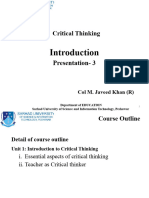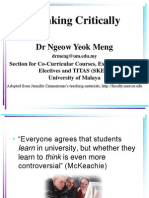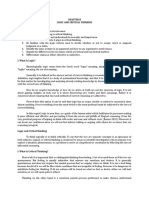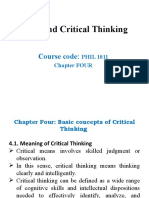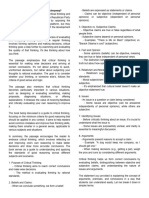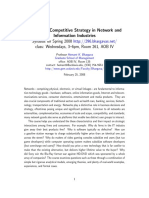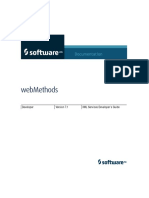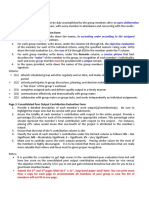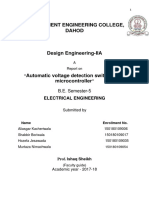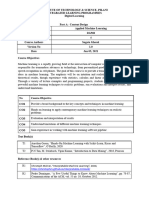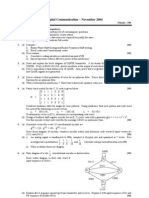Name: Nguyễn Ngọc Khánh Hân
Class: 22SPA02
END-OF-TERM TEST
PART 1:
Question 1:
Critical thinking can be understood as a way of thinking that involves analyzing and evaluating
information or ideas in a careful and thoughtful way. It is not only about accepting things at face value
but also questioning and examining them from different perspectives. Critical thinking helps us make
informed decisions, solve problems, and form well-reasoned judgments by overcoming biases and false
preconceptions.
In an academic context, critical thinking is important because it allows us to see many aspects of an
issue. Instead of judging by our narrow view of ourselves, critical thinking encourages us to dig deeper
into the content, understand basic concepts, and develop our own interpretations with facts and
evidence. It helps us assess the reliability of sources, evaluate arguments, and identify any biases or
logical fallacies. By developing critical thinking skills, students become active learners who can approach
complex problems with critical and analytical thinking.
In real-life situations, critical thinking is equally important. It helps us navigate the vast amount of
information available, especially in the digital age. Critical thinking allows us to distinguish between
reliable sources and misleading ones, enabling us to make well-informed decisions. It also helps us solve
problems effectively by encouraging us to consider multiple perspectives, evaluate potential solutions,
and anticipate potential consequences. Critical thinking empowers us to think independently, challenge
assumptions, and adapt to new situations, which are vital skills in our personal and professional lives.
Overall, critical thinking is essential both in academic and real-life contexts because it equips us with the
skills to analyze information, make reasoned judgments, and approach challenges with a thoughtful and
logical mindset. It enhances our ability to learn, understand the world around us, and make informed
choices, ultimately leading to better academic performance and more effective problem-solving in
various aspects of life.
Question 2:
Critical thinking consists of two main components: cognitive skills and intellectual disposition. Cognitive
skills encompass thought processes such as remembering, understanding, applying, analyzing,
evaluating, and creating. Remembering involves recalling information, while understanding entails
grasping the meaning behind it. Applying refers to using knowledge in practical situations, while
analyzing involves breaking down complex ideas. Evaluation entails assessing information or arguments,
and creating involves generating new ideas or solutions. On the other hand, intellectual disposition
refers to the attitudes and habits of mind that support critical thinking. These include open-mindedness,
curiosity, skepticism, intellectual humility, perseverance, fair-mindedness, and reflectiveness.
�Name: Nguyễn Ngọc Khánh Hân
Class: 22SPA02
The cognitive skills of critical thinking allow individuals to process information effectively and engage
with it at various levels. Remembering and understanding lay the foundation, while applying, analyzing,
evaluating, and creating involve higher-order thinking that facilitates problem-solving and decision-
making. Intellectual disposition, meanwhile, fosters a mindset conducive to critical thinking. Open-
mindedness encourages considering different perspectives, while curiosity drives exploration and
discovery. Skepticism prompts questioning and seeking evidence, while intellectual humility promotes
intellectual growth. Perseverance helps overcome challenges, and fair-mindedness ensures impartiality.
Reflectiveness facilitates self-assessment and continuous improvement. Together, these cognitive skills
and intellectual dispositions form the basis for developing strong critical thinking abilities, enabling
individuals to navigate academic, professional, and personal contexts with discernment and sound
judgment.
Question 3:
Critical thinkers possess several traits or characteristics that contribute to their effective use of critical
thinking. There are some important traits that I would mention, including a passionate drive for clarity,
precision, and accuracy, sensitivity to potential impediments to critical thinking, skill in understanding
and evaluating arguments, and intellectual honesty.
First and foremost, critical thinkers have a passionate drive for clarity, precision, and accuracy. They strive
to ensure that their thinking and communication are clear, precise, and accurate. This trait enables them
to analyze information and ideas with meticulous attention to detail, ensuring that their assessments are
well-founded and logical.
Moreover, critical thinkers are sensitive to potential impediments that can skew their critical thinking.
They recognize the influence of egocentrism, sociocentrism, wishful thinking, and other biases that can
distort reasoning. This awareness allows them to identify and overcome these impediments, ensuring
that their thinking remains objective and unbiased.
Furthermore, critical thinkers possess the skill of understanding and evaluating arguments. They can
identify the structure and components of an argument, assess the strength of evidence and reasoning,
and recognize fallacies or flaws in thinking. This skill helps them separate valid arguments from weak
ones and make well-informed judgments.
Besides, critical thinkers demonstrate intellectual honesty. They are willing to acknowledge what they
don't know and recognize their own limitations. This trait fosters humility and an openness to new ideas
or perspectives, allowing critical thinkers to continuously learn, grow, and refine their thinking.
These traits contribute to effective critical thinking by promoting accurate analysis, unbiased evaluation,
and logical reasoning. They enable critical thinkers to approach problems or issues with clarity, navigate
through potential obstacles, and arrive at well-supported conclusions. Ultimately, these traits empower
individuals to think critically, make sound judgments, and engage in thoughtful decision-making
processes.
�Name: Nguyễn Ngọc Khánh Hân
Class: 22SPA02
PART 2:
Question 4: "Climate change is a significant global issue. The increase in average global temperatures,
the rising sea levels, and the melting of polar ice caps are clear evidence of this phenomenon. Therefore,
urgent action is needed to reduce greenhouse gas emissions and transition to renewable energy
sources."
Premise 1: Climate change is a significant global issue.
Premise 2: The increase in average global temperatures, the rising sea levels, and the melting of polar ice
caps are clear evidence of this phenomenon.
Conclusion: Therefore, urgent action is needed to reduce greenhouse gas emissions and transition to
renewable energy sources.
The premises in the argument highlight the evidence supporting the claim that climate change is a
significant global issue. The increase in average global temperatures, rising sea levels, and melting polar
ice caps are provided as specific examples that demonstrate the reality of climate change. The
conclusion of the argument is that urgent action is required. This action involves two components:
reducing greenhouse gas emissions and transitioning to renewable energy sources. The claim is based on
the understanding that addressing climate change is necessary in light of the evidence provided in the
premises.
Question 5: "All mammals are warm-blooded animals. Elephants are mammals. Therefore, elephants
are warm-blooded animals."
The given argument is deductive.
In deductive reasoning, the conclusion is claimed to necessarily follow from the premises. In this
argument, the first premises is "All mammals are warm-blooded animals." The second premise states
that "elephants are mammals." Given that all mammals are warm-blooded animals and elephants are
mammals, it logically follows that elephants must be warm-blooded animals. The conclusion directly
follows from the premises, and there is not ambiguity or uncertainty. Therefore, the argument is
deductive.
Question 6: "If we ban guns, then only criminals will have guns. Therefore, we should not ban guns."
The two logical fallacies present in the given argument are:
1. Slippery Slope: The pattern for the argument "If we ban guns, then only criminals will have guns.
Therefore, we should not ban guns" can be described as follows:
The arguer claims that if a certain action, banning guns, is taken (A), it will lead to a series of
negative consequences, such as only criminals having guns (B).
The arguer holds that B is an undesirable outcome and therefore argues against taking action A
(not banning guns).
�Name: Nguyễn Ngọc Khánh Hân
Class: 22SPA02
In fact, there is no sufficient evidence or reasoning provided to support the claim that action A
(banning guns) will inevitably result in B (only criminals having guns). The argument relies on an
unsubstantiated assumption and fails to consider potential alternative outcomes or the
effectiveness of regulations.
The pattern involves predicting a chain of events based on a specific action and using the undesirability
of the final outcome to argue against taking that initial action. However, it lacks substantive evidence or
logical reasoning to establish a causal relationship between the action and the predicted consequences.
2. False Alternatives: The arguer presents a false either/or choice by asserting that the only options are
either banning guns or allowing criminals to have guns. But this argument overlooks other possibilities
and reasonable solutions. It simplifies the situation too much. There are other ways to handle gun
control, such as having stricter rules, background checks, or finding a balance between gun ownership
and public safety. By limiting the choices to just banning guns or letting criminals have them, the
argument misses the chance to consider different approaches. It assumes that banning guns is the only
way to stop criminals from having them, without considering other effective methods or policies.
PART 3:
Question 7: "Aliens exist because there is no evidence that they do not. Until there is solid proof of
their non-existence, we must consider the possibility of their existence."
The argument given is not valid because it commits the fallacy of appeal to ignorance. This fallacy occurs
when one argues that something is true because it has not been proven false, or that something is false
because it has not been proven true. In this case, the argument assumes that the lack of evidence for the
non-existence of aliens implies the possibility of their existence, which is not logically valid. Reconstruct
the argument:
Premise 1: If there is life on other planets, then aliens exist.
Premise 2: There is life on other planets.
Conclusion: Therefore, aliens exist.
This argument is valid because it has the form of “modus ponens”, a valid argument form that goes like
this:
- If P, then Q.
- P.
- Therefore, Q.
In this form, the conclusion follows necessarily from the premises. If the premises are true, the
conclusion must be true. It is impossible for the premises to be true and the conclusion false. The
�Name: Nguyễn Ngọc Khánh Hân
Class: 22SPA02
premises provide logically conclusive grounds for the truth of the conclusion. It is logically inconsistent to
assert both premises as true and deny the conclusion.
Question 8: "The government should increase funding for education because a well-educated
population leads to economic growth and social stability." The argument has the following structure:
- Premise: A well-educated population leads to economic growth and social stability.
- Conclusion: The government should increase funding for education.
The argument is an example of a normative argument, which is an argument that makes a value
judgment or a recommendation based on some moral or practical standard. Normative arguments often
have an implicit premise that states the standard or criterion that is used to evaluate the conclusion. In
this case, the implicit premise is something like:
- Implicit premise: The government should promote economic growth and social stability.
This premise is an assumption that the arguer makes, but does not explicitly state. It expresses a value or
a goal that the arguer thinks the government should have. Without this premise, the argument would
not be valid, because the premise alone does not imply the conclusion. The premise only tells us what a
well-educated population leads to, not why the government should care about it. The implicit premise
provides the link between the premise and the conclusion by stating the criterion that justifies the
recommendation.
PART 4:
Question 9:
The political opinion piece presents an argument about taxes and economic growth. However, it contains
several fallacies that weaken the overall strength of the argument.
Firstly, the argument makes a Hasty generalization by stating that high taxes hinder economic growth
without providing sufficient evidence or reasoning to support this claim. This weakens the argument's
persuasiveness by relying on limited information and failing to consider other factors that may affect the
relationship between taxes and economic growth.
Furthermore, the argument includes a Slippery slope fallacy. It suggests that any tax increase should be
avoided and alternative funding sources should be pursued. However, this assumption lacks proper
evidence or logical reasoning to establish a direct connection between higher taxes and negative
consequences for economic growth. Without substantiating this claim, the argument becomes less
convincing.
Lastly, the argument exhibits Inconsistency fallacy. On one hand, it acknowledges the need to increase
taxes for funding social programs, but on the other hand, it advocates against any tax increases. This
inconsistency weakens the overall argument and raises doubts about the author's credibility. By
�Name: Nguyễn Ngọc Khánh Hân
Class: 22SPA02
presenting conflicting positions, the argument lacks coherence and fails to establish a strong and
persuasive standpoint.
In conclusion, the political opinion piece contains fallacies such as hasty generalization, slippery slope
fallacy, and inconsistency. These flaws undermine the strength of the argument and reduce its
persuasiveness. By addressing these issues and providing solid evidence and logical reasoning, the
author can enhance the credibility and effectiveness of their argument.
Question 10:
a. Main arguments:
Article 1:
1. Most approaches focus on limited perspectives on cognition or simply ignore the
political, psychological, and philosophical aspects of the concept of intelligence. For the
purpose of our analysis of the impact of artificial intelligence in teaching and learning in
higher education, we propose a basic definition informed by the literature review of
some previous definitions on this field. Thus, we can define artificial intelligence (AI) as
computing systems that are able to engage in human-like processes such as learning,
adapting, synthesizing, self-correction and use of data for complex processing tasks.
2. As we note that significant advances in machine learning and artificial intelligence open
new possibilities and challenges for higher education, it is important to observe that
education is eminently a human-centric endeavor, not a technology centric solution.
3. Maintaining academic skepticism on this issue is especially important in education, as
this is an act that can be reduced to information delivery and recollection; we need to
maintain its aim to build educated minds and responsible citizens that are attached to
general values of humanism.
4. With the rise of AI solutions, it is increasingly important for educational institutions to
stay alert and see if the power of control over hidden algorithms that run them is not
monopolized by tech-lords.
5. The set of risks is too important to be overlooked and not explored with courage and
careful analysis. At the same time, the rapid advancements of AI are doubled by the
effort of defunded universities to find economic solutions to balance depleted budgets.
AI already presents the capability to replace a large number of administrative staff and
teaching assistants in higher education. It is therefore important to explore the effects of
these factors on learning in higher education, especially in the context of an increasing
demand for initiative, creativity, and ‘entrepreneurial spirit’ for graduates.
Article 2:
1. Artificial intelligence (AI) can be defined briefly as the branch of computer science that
deals with the simulation of intelligent behavior in computers and their capacity to
mimic, and ideally improve, human behavior.
2. Various applications of AI in educational settings include personalized learning platforms
to tailor instruction to individual students’ needs, preferences, and goals; automated
�Name: Nguyễn Ngọc Khánh Hân
Class: 22SPA02
assessment systems to provide feedback, grading and analytics to teachers and students;
facial recognition systems to monitor students’ engagement, emotions and behaviors;
connected students and teachers through social networking sites (SNSs).
3. Most studies reflect university students’ engagement with ethical ideas about
algorithmic bias, but few addresses how to promote students’ understanding of AI and
ethics in K-12 settings. Therefore, this article: (a) synthesizes ethical issues surrounding
AI in education as identifed in the educational literature, (b) refects on diferent
approaches and curriculum materials available for teaching students about AI and ethics
(i.e., featuring materials from the MIT Media Lab and Code. org), and (c) articulates
future directions for research and recommendations for practitioners seeking to navigate
AI and ethics in K-12 settings.
4. Personalized learning systems, automated assessments, facial recognition systems,
chatbots (social media sites), and predictive analytics tools are being deployed
increasingly in K-12 educational settings; they are powered by machine learning systems
and algorithms. These applications of AI have shown promise to support teachers and
students in various ways
5. Considering the different forms of bias and ethical challenges of AI applications in K-12
settings, we will focus on problems of privacy, surveillance, autonomy, bias, and
discrimination. However, it is important to acknowledge that educators will have diferent
ethical concerns and challenges depending on their students’ grade and age of
development.
6. These ethical concerns suggest an urgent need to introduce students and teachers to the
ethical challenges surrounding AI applications in K-12 education and how to navigate
them. To meet this need, diferent research groups and nonproft organizations offer a
number of open-access resources based on AI and ethics. They provide instructional
materials for students and teachers, such as lesson plans and hands-on activities, and
professional learning materials for educators, such as open virtual learning sessions.
b.
Similarities * Both articles explore the phenomena of the emergence of the use of artificial intelligence
(AI) in education and its implications for teaching and learning.
* Both articles acknowledge the potential benefits of AI in education, such as enhancing
student outcomes, motivation, and creativity; supporting teacher professional development,
decision making, and workload reduction; and improving educational equity, accessibility, and
inclusion.
* Both articles also recognize the ethical challenges and dilemmas of using AI in education,
such as privacy and data protection, bias and discrimination, ethical literacy and agency, and
human-machine interaction.
* Both articles recommend teaching and understanding of AI by providing instructional
resources for students and teachers to advance their knowledge and skills on AI and ethics.
�Name: Nguyễn Ngọc Khánh Hân
Class: 22SPA02
Differences Artificial intelligence in education: Addressing Exploring the impact of artificial
ethical challenges in K-12 settings intelligence on teaching and learning in
higher education
focuses on K-12 settings focuses on higher education
defines AI through the concepts of settings
machine learning and algorithms defines AI as the simulation of
introduces specific applications of AI in intelligent behavior in computers
educational settings, such as and their capacity to mimic, and
personalized learning platforms, ideally improve, human behavior.
automated assessment systems, and does not provide concrete
facial recognition systems examples of AI applications in
provides recommended instructional higher education.
resources from two providers: MIT's does not suggest any specific
Media Lab and Code.org resources for teaching and learning
about AI.
c.
- The article “Artificial intelligence in education: Addressing ethical challenges in K-12 settings” has a
clear and coherent structure, with an introduction, four main sections, and a conclusion. The arguments
are relevant to the topic of AI and ethics in K-12 education and address the needs and interests of
practitioners and researchers in this field. The arguments are mostly valid and sound, as they provide
definitions, examples, explanations, and references for their claims. However, some arguments could be
improved by providing more evidence or analysis for their premises or conclusions. For example, the
authors could provide more empirical data or case studies to support their claims about the benefits and
challenges of AI in education, or they could discuss more critically the limitations or implications of their
recommended instructional resources.
- The article “Exploring the impact of artificial intelligence on teaching and learning in higher
education” has a less clear and coherent structure, with an introduction, three main sections, and a
conclusion. The arguments are somewhat relevant to the topic of AI and education in higher education,
but they are more general and abstract than specific and concrete. The arguments are not very valid or
sound, as they rely heavily on assumptions, opinions, or biases, without providing sufficient evidence or
explanation for their claims. For example, the authors make sweeping predictions about the future of
higher education in a world where AI is part of the fabric of our universities, but they do not provide any
empirical data or case studies to support their scenarios. They also make normative judgments about the
challenges and risks of AI in education, but they do not provide any ethical principles or standards to
guide their evaluations.
d.
Artificial Intelligence (AI) has emerged as a powerful tool in various fields, and its integration into
education holds significant promise. In the context of education, AI refers to the use of advanced
technologies to simulate intelligent behavior in computers, allowing them to mimic and enhance human
�Name: Nguyễn Ngọc Khánh Hân
Class: 22SPA02
capabilities. AI has found its way into education through personalized learning platforms, automated
assessment systems, and facial recognition technologies, among others.
One of the key applications of AI in education is the development of personalized learning platforms.
These platforms leverage AI algorithms to tailor instruction to individual students' needs, preferences,
and goals. By analyzing data on students' learning styles and performance, AI can provide customized
learning experiences that optimize engagement and improve learning outcomes. This individualized
approach enables students to learn at their own pace and focus on areas where they need additional
support, fostering a more effective learning environment. Automated assessment systems powered by AI
have also revolutionized the way student learning is evaluated. These systems provide timely and
accurate feedback, grading, and analytics to both teachers and students. By automating routine
assessment tasks, teachers can save time and allocate more energy to providing personalized support to
students. Additionally, students receive immediate feedback on their progress, enabling them to identify
areas for improvement and take ownership of their learning journey.
While AI presents significant benefits for students and teachers, it also brings forth ethical challenges
and dilemmas that require careful consideration. One prominent concern is privacy and data protection.
With AI systems collecting vast amounts of student data, there is a risk of unauthorized access, data
breaches, or misuse of personal information. Safeguarding student privacy is crucial to ensure their trust
and maintain ethical standards in education. Bias and discrimination are additional ethical challenges. AI
algorithms can inadvertently perpetuate existing biases and inequalities. If the training data used to
develop AI systems contains biased information, it may lead to unfair outcomes or discrimination against
certain groups of students. Addressing this challenge requires careful monitoring and mitigation of
algorithmic biases to ensure fairness and equal opportunities for all learners. Ethical literacy and agency
are also important considerations. As AI systems become more prevalent in education, it is essential for
students and teachers to develop the necessary skills to critically evaluate and understand AI
technologies. Promoting ethical literacy empowers individuals to navigate AI tools responsibly and make
informed decisions. Moreover, human-machine interaction is a crucial aspect. While AI can enhance
teaching and learning experiences, it should never replace human interaction and personalized
guidance. Maintaining a balance between AI and human involvement is crucial to ensure a holistic and
comprehensive education.
In conclusion, the integration of AI in education offers tremendous potential benefits for both students
and teachers. Personalized learning platforms and automated assessment systems enhance the learning
experience, facilitating tailored instruction and timely feedback. However, careful consideration must be
given to privacy concerns and the maintenance of a healthy balance between technology and human
interaction. As AI continues to advance, its responsible and thoughtful implementation can pave the way
for an innovative and inclusive educational landscape.



